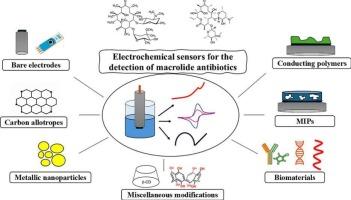Electrochemical sensors for the detection of macrolide antibiotics: a review
IF 4.9
2区 化学
Q1 CHEMISTRY, ANALYTICAL
引用次数: 0
Abstract
Antibiotics have transformed medicine by effectively treating infectious diseases in humans and livestock. However, their misuse has led to the rise of antibiotic-resistant bacteria, making antimicrobial resistance a significant public health challenge of the 21st century. Among the various antibiotic families, macrolides are one of the most frequently prescribed antibiotics. The recent increase in research on electrochemical sensors for macrolide antibiotics (MAs) detection highlights the need for a critical review to summarize recent developments, address current challenges, and outline future research directions, filling a notable gap in literature. While existing reviews have addressed electrochemical detection of other antibiotic classes, there is a conspicuous gap regarding MAs, likely due to historical focus shifts stemming from concerns over serious side effects associated with macrolide derivatives. However, recent advancements have reignited interest in this class, suggesting a macrolide renaissance with potential for novel, safe antibiotics.
This review outlines various electrochemical techniques employed for MAs detection, focusing on surface modifications and detection mechanisms. Electrode surface modifications have enhanced the electroanalytical performance of sensors, enabling the detection of trace levels of MAs in complex samples such as pharmaceuticals, biological fluids, and food matrices. However, the extent of these improvements is often debated in real-world applications. Further advancements are essential to address specific limitations and validate the reliability of electrochemical methods over traditional separation-based techniques. Despite these hurdles, electrochemical sensing offers significant potential for managing and monitoring MAs across various samples, with integration of smartphones and communication devices enhancing the accessibility of point-of-care testing.

电化学传感器检测大环内酯类抗生素的研究进展
抗生素通过有效地治疗人类和牲畜的传染病,改变了医学。然而,它们的滥用导致耐抗生素细菌的增加,使抗菌素耐药性成为21世纪的重大公共卫生挑战。在各种抗生素家族中,大环内酯类是最常用的抗生素之一。近年来,大环内酯类抗生素(MAs)检测电化学传感器的研究日益增多,因此有必要对其进行综述,总结最新进展,解决当前的挑战,并概述未来的研究方向,填补文献中的显著空白。虽然现有的综述已经解决了其他抗生素类的电化学检测,但在MAs方面存在明显的差距,这可能是由于对大环内酯衍生物相关严重副作用的担忧而引起的历史焦点转移。然而,最近的进展重新点燃了人们对这类药物的兴趣,这表明大环内酯类药物的复兴具有开发新型安全抗生素的潜力。本文概述了用于MAs检测的各种电化学技术,重点是表面修饰和检测机制。电极表面修饰增强了传感器的电分析性能,能够检测复杂样品(如药品、生物流体和食品基质)中的痕量MAs。然而,这些改进的程度在实际应用中经常存在争议。进一步的进展对于解决特定的限制和验证电化学方法相对于传统的基于分离的技术的可靠性至关重要。尽管存在这些障碍,电化学传感为管理和监测各种样品中的MAs提供了巨大的潜力,智能手机和通信设备的集成提高了即时检测的可及性。
本文章由计算机程序翻译,如有差异,请以英文原文为准。
求助全文
约1分钟内获得全文
求助全文
来源期刊

Microchemical Journal
化学-分析化学
CiteScore
8.70
自引率
8.30%
发文量
1131
审稿时长
1.9 months
期刊介绍:
The Microchemical Journal is a peer reviewed journal devoted to all aspects and phases of analytical chemistry and chemical analysis. The Microchemical Journal publishes articles which are at the forefront of modern analytical chemistry and cover innovations in the techniques to the finest possible limits. This includes fundamental aspects, instrumentation, new developments, innovative and novel methods and applications including environmental and clinical field.
Traditional classical analytical methods such as spectrophotometry and titrimetry as well as established instrumentation methods such as flame and graphite furnace atomic absorption spectrometry, gas chromatography, and modified glassy or carbon electrode electrochemical methods will be considered, provided they show significant improvements and novelty compared to the established methods.
 求助内容:
求助内容: 应助结果提醒方式:
应助结果提醒方式:


